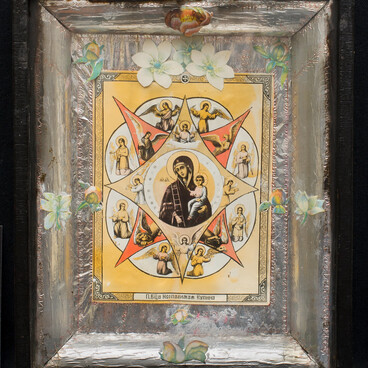The Museum of Local History and Lore has several types of irons on display; most of them are coal-fired models. This type of iron got its name from the manner in which it was heated up: birch charcoal was put inside the iron and the lid was then closed. Special holes were poked in the sides to help the burning process within.
This type of iron was not particularly easy or safe to use: sparks and small pieces of coal would often get tossed out from inside the iron, leaving burnt marks and even making holes in the clothes. To avoid this sort of accident, an improved iron design was developed: it was completely closed in but had a pipe to improve the draft so it looked like a miniature oven. A blower with a lid was made in the back.
The lid of the blower on the iron the museum acquired in 1969 has a base relief of the great 19th-century Russian writer Leo Tolstoy in his old age. Count Tolstoy was excommunicated from the Russian Orthodox church for his heretical teachings. To mark that development, iron makers in the town of Vereya manufactured a batch of irons with a schematic portrait of the writer right next to the hot coals to symbolize how he was now going to burn in the lake of fire.
Coal-fired irons were expensive and the masses couldn’t afford them: they were regarded as a luxury and were often passed down the generations. A coal-fired iron was thus also regarded as a status symbol and was often put on display next to the samovAr on a lace tablecloth.
The history of irons goes back hundreds of years. In the 4th century BC in Ancient Greece, clothes were smoothed using a hot metal rod, which resembled a rolling pin. Ancients also used somewhat heated stones to get wrinkles out of clothes. In Mahmud Kashgari’s treatise Divan Lugat At-Turk written in the 11th century, there is a mention of this domestic appliance: ‘an utuk (iron) is a piece of iron shaped like a shovel that is heated up and used to heat up piles of clothes and smooth clothes out.’
In the 13th through 19th centuries, the irons acquired a shape that was very similar to what they are shaped like today. By the mid-18th century, coal-fired irons emerged. The most common type of iron were irons that had to be heated up on a stove. Alcohol-fired irons were far more expensive: in the 19th century, an iron like that could be traded for a small flock of sheep. Electrically heated irons began to be produced in the late 19th century.
This type of iron was not particularly easy or safe to use: sparks and small pieces of coal would often get tossed out from inside the iron, leaving burnt marks and even making holes in the clothes. To avoid this sort of accident, an improved iron design was developed: it was completely closed in but had a pipe to improve the draft so it looked like a miniature oven. A blower with a lid was made in the back.
The lid of the blower on the iron the museum acquired in 1969 has a base relief of the great 19th-century Russian writer Leo Tolstoy in his old age. Count Tolstoy was excommunicated from the Russian Orthodox church for his heretical teachings. To mark that development, iron makers in the town of Vereya manufactured a batch of irons with a schematic portrait of the writer right next to the hot coals to symbolize how he was now going to burn in the lake of fire.
Coal-fired irons were expensive and the masses couldn’t afford them: they were regarded as a luxury and were often passed down the generations. A coal-fired iron was thus also regarded as a status symbol and was often put on display next to the samovAr on a lace tablecloth.
The history of irons goes back hundreds of years. In the 4th century BC in Ancient Greece, clothes were smoothed using a hot metal rod, which resembled a rolling pin. Ancients also used somewhat heated stones to get wrinkles out of clothes. In Mahmud Kashgari’s treatise Divan Lugat At-Turk written in the 11th century, there is a mention of this domestic appliance: ‘an utuk (iron) is a piece of iron shaped like a shovel that is heated up and used to heat up piles of clothes and smooth clothes out.’
In the 13th through 19th centuries, the irons acquired a shape that was very similar to what they are shaped like today. By the mid-18th century, coal-fired irons emerged. The most common type of iron were irons that had to be heated up on a stove. Alcohol-fired irons were far more expensive: in the 19th century, an iron like that could be traded for a small flock of sheep. Electrically heated irons began to be produced in the late 19th century.



